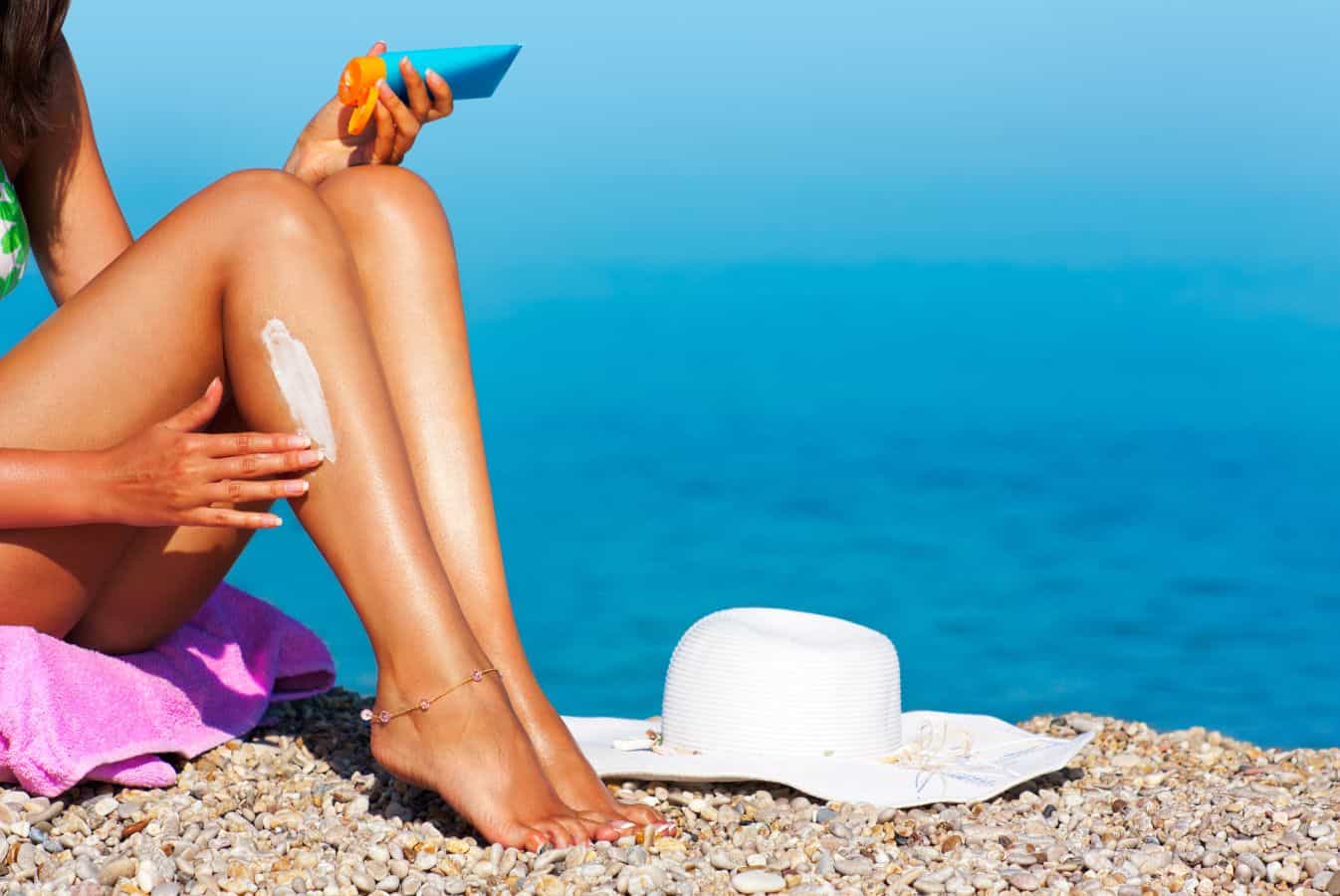Sunburn and suntan are both ways that our skin reacts to sunlight, specifically to the ultraviolet (UV) rays from the sun. However, they are different in how they appear and how they affect the health of our skin.
In short, sunburn is what happens when your skin gets inflamed from too much sunlight, while a tan is your skin trying to defend itself from more damage.
So, does sunburn turn into tan? In this article, we’ll look at all the factors.
Table of Contents
What is a Sunburn?
Sunburn is the skin’s response to too much exposure to UV rays, especially UVB rays. When you get a sunburn, your skin becomes red, hurts, and might swell. You could also experience itching, peeling, or even blisters.
Sunburns can harm the DNA in your skin cells, raising the risk of skin cancer like melanoma, as well as making your skin age faster.
What is a Tan?
A suntan is how your skin tries to protect itself from UV rays, mainly UVA rays.
When your skin tans, special cells called melanocytes create more melanin, the pigment that gives your skin its color. Melanin absorbs and spreads out the UV rays to protect your skin cells from harm.
Having a tan can give you some protection against sunburn, but it won’t stop it completely.
Tanning might make your skin look better for a short time, but too much time in the sun can cause early aging, damage to your skin, and a higher risk of skin cancer.
Getting a tan really comes down to your skin type
Melanin is responsible for skin color, and people with lighter skin have less of it, making them more prone to sunburns. Meanwhile, individuals with darker skin possess more melanin, which makes them less susceptible to burns and more prone to tanning. Moreover, people with particular skin conditions or who are taking certain medications may be more sensitive to the sun and less likely to tan.
How Long Does it Take for a Sunburn to Heal?
How long it takes for a sunburn to get better depends on how bad the burn is and things like your skin type and overall health. Sunburns can be grouped into three levels of seriousness:
Mild sunburn (first-degree)
Mild sunburns usually cause your skin to be red, warm, and a little uncomfortable. They often get better in 3 to 5 days. To help the healing process, you can use aloe vera or over-the-counter creams with hydrocortisone, keep your skin moisturized, and drink plenty of water.
Moderate sunburn (second-degree):
Moderate sunburns can make your skin very red, painful, swollen, and sometimes cause blisters. These sunburns might take about 1 to 2 weeks to get better. Make sure to keep the area clean, use cold compresses, and don’t pop any blisters. Over-the-counter pain relievers can help with the pain.
Severe sunburn (second-degree or higher)
Severe sunburns can cause a lot of blisters, extreme pain, and even fever, chills, or feeling sick. These sunburns can take 2 weeks or more to heal, and you should talk to a doctor for the right treatment and care.
Does Sunburn Turn into Tan?
Sunburn and suntan are different ways your skin reacts to being in the sun, and they happen because of different reasons. The simple answer, but not the definitive one you might want to hear, is that a tan might show up after a sunburn, but it’s not always the case.
After your sunburn gets better, your skin might turn into a tan because the redness goes away and the extra melanin becomes more noticeable. But this doesn’t always happen, and it’s key to understand that both sunburns and tans are signs that your skin has been hurt.
How Long Does it Take for a Sunburn to Turn into a Tan?
How long it takes for a sunburn to become a tan, if it even does, depends on things like how bad the sunburn is, your skin type, and how your skin usually reacts to being in the sun. Remember that not all sunburns will turn into tans.
For mild sunburns, the redness and pain may start to go away in 3 to 5 days, and the extra melanin your skin makes has a chance of showing up as a tan once the sunburn gets better.
With moderate sunburns, which can cause very red skin, pain, and swelling, it might take about 1 to 2 weeks for the sunburn to heal. A tan is not likely to show up after the sunburn goes away.
It’s unlikely that a severe sunburn will turn into a tan, and you should talk to a doctor for the right treatment and care.
How to Keep a Sunburn From Peeling (And Start Tanning)
Even though you might want to stop a sunburn from peeling and get a tan, you should let your skin peel by itself after getting a tan. Peeling is a normal thing that happens when your body gets rid of the top layer of dead skin cells. It’s a sign that your skin has been hurt by being in the sun, even if it’s just a tan and not a sunburn
Still, you can do some things to help your skin heal and keep it from peeling after a sunburn while making sure to protect your skin from more damage.
Start By Relieving the Sunburn Pain
After getting a sunburn, it’s crucial to help with the pain and make the healing process go smoother. Taking good care of your skin can also make it hurt less and stop problems like infection or scars from happening. Here are some things you can do to help with sunburn pain and help your skin heal:
Cool your skin: Use cold cloths or take cool baths or showers to make your sunburn feel better and make the swelling go down. Don’t put ice right on your skin because it could hurt it more.
Take pain medicine you can get without a prescription: Use pain medicine like ibuprofen or acetaminophen to help with the swelling and make the pain go away. Follow the directions on the bottle and talk to your doctor if you’re worried about anything.
Use Aloe Vera Gel: Putting this on a burn can help with the pain. It is naturally good at fighting inflammation, cooling down, and calming, which makes it a great way to treat sunburned skin. It can help the redness go away, make the burning feel better, and help your skin heal.
Use Cucumber Slices on Your Skin: When you put cucumber slices on the sunburn, they can help with the swelling, make the burning feel better, and cool your skin down.
Cucumbers are full of water, which can give moisture to the hurt area. They also have antioxidants and are naturally good at cooling down, making them a calming way to treat sunburned skin.
Healing Your Sunburn
To help a sunburn heal and feel better, follow these steps:
Use moisturizer: Put a gentle, unscented moisturizer or aloe vera gel on the part of your skin with the sunburn to keep it from drying out and help stop it from peeling. Don’t use products that have petroleum or alcohol in them because they might keep heat in and make your skin feel worse.
Drink water: Make sure to drink enough water so your body can heal and your skin stays hydrated.
Keep your skin safe from more sun: Keep the sunburned part of your skin covered and use sunscreen with SPF 30 or higher when you go outside. Find shade and wear clothes that cover your skin, hats, and sunglasses to stop more sun damage from happening.
Wear clothes that aren’t tight and feel soft: Pick clothes that are loose and soft so they don’t make your sunburn feel worse.
Don’t touch the sunburned skin: Keep yourself from picking at or peeling the skin, because this can make scars or get your skin infected.
Usually, sunburns will get better on their own in a few days to a couple of weeks. But, if your sunburn is really bad, and you have a lot of blisters, extreme pain, a high fever, the shakes, or feel confused, talk to a doctor to get the right treatment and help. Remember that it’s important to not get sunburned in the first place, and make sure you protect your skin from the sun so it doesn’t get hurt and have long-term problems.
What to Avoid When Treating a Sunburn
It’s important to know what to avoid that can make it worse. Here are some things you should stay away from when treating a sunburn:
Hot water:
Don’t take hot showers or baths because it can dry out your skin more and make it hurt more.
Popping blisters:
Popping a blister caused by sunburn is not advisable, as it can lead to further damage and delay the healing process. The blisters are a natural way for the body to protect and promote healing in the damaged skin. When a blister is popped, the underlying sensitive skin is exposed to potential infection, which can result in scarring or other complications. Moreover, the pain associated with popping a blister can be significant, and the open wound may take longer to heal than the initial blister. In the event of a large or painful blister, it is advisable to seek medical attention for proper treatment. Otherwise, it is recommended to let the blister heal naturally.
Harsh products:
Don’t use products with alcohol, fragrances, or retinoids because they can make your skin hurt more and cause more damage.
Tight clothes:
Don’t wear clothes that are tight or rub against your sunburn because it can make you feel worse.
More sun:
Don’t spend time in the sun without protecting your skin because it can make your sunburn worse and increase your chances of long-term skin damage
Consider tanning alternatives
If you want to avoid sun tanning, there are various alternatives you can consider, including:
Self-tanning products: These come in different forms, such as lotions, sprays, and mousses, and can give you a natural-looking tan without the risks associated with UV exposure.
Spray tans: This option involves a professional using a spray gun and a special tanning solution to give you a quick and even tan without the need for UV radiation.
Tanning beds: Although they still expose your skin to UV rays, tanning beds may be a safer alternative to sun tanning as the intensity and duration of exposure can be controlled.
Bronzing makeup: Applying bronzing makeup to your skin can give you a temporary tan effect that can be easily washed off, making it a good option for those who want to avoid UV exposure.
Clothing and accessories: Covering your skin with clothing or using hats, sunglasses, and umbrellas can also provide protection from the sun and an alternative to sun tanning.








